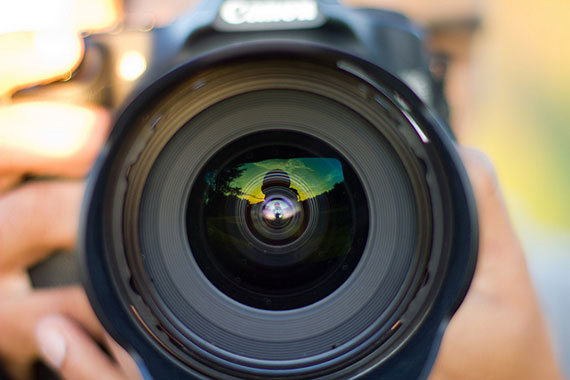Perhaps one of the more confusing subjects in the world of digital cameras is lens length. We hear terms like “telephoto,” “wide angle,” “field of view,” “5X,” and a host of others to describe our lenses. Then once we get all of that business sorted out we crank in other arcane phrases like “crop factor” and “35mm equivalent.” Is it any wonder that it’s tough to make a decision on a lens?

Photo by Korina Segaya; ISO 1250, f/1.8, 1/60-second exposure.
While it is easy to grasp that a longer lens length offers more magnification and a short lens length provides a wider view, it helps to understand what a standard lens length is before we begin making comparisons.
There is a way to use math to determine what constitutes a standard lens length for any camera, and I’ll add that bit of mathematic fun at the end of this discussion. That kind of mental gymnastics is interesting stuff to us photo geeks but the other 98 percent of the world, I believe, would rather have a root canal.
That said, we are going to make an assumption: On average, digital cameras using an APS-sized image sensor will have a standard (sometimes called normal) lens length of 28mm.
OK, big deal, what does it mean? What this little bit of information tells us is that if we mount a lens on a DSLR and set it to a length of 28mm, the view through the camera shows the world in the same perspective as we might see it through one open eye. In other words, this is a “normal” or “standard” lens length. We have our benchmark length that can be used to compare lenses.
Let’s do some mental housekeeping first. I would like to encourage you to disregard a few terms. We can forget “crop factor” and “35mm equivalent” for now. Since the majority of new DSLR camera buyers never owned a film camera with interchangeable lenses, these terms simply add needless layers of numbers and confusion.
Another term to set aside for the moment is the “X Factor.” Compact camera lenses are described with phrases like “5X zoom lens,” which frankly is kind of meaningless. Expressing lens length this way is handy but ineffective and here’s why. A lens that is 20-100mm is a 5X lens, but then so is a 50-250mm lens. The “X Factor” is ad-speak and only superficially useful in the world of compact cameras.

Photo by Albert Huynh; ISO 100, f/1.4, 1/50-second exposure.
So we are left with wide angle, telephoto, and field of view. These are three good terms we can sink our teeth into, and here’s how: As we have just discussed, a DSLR with a 28mm lens has a field of view similar to that of one open eye. Any lens length shorter than 28mm will have a wider field of view (wide angle), a longer lens a narrower field of view (telephoto).
There is some easy, do-it-in-your-head math that we can now use to compare lenses. If 28mm is a normal view, then a lens that is 14mm will have a view twice as wide. A lens of 50mm will provide a view almost two times closer. Do we really care what the 35mm film camera equivalent or the crop factor is? Nope.
So in the real world we can now make some well informed judgments when we compare camera lenses. If we are offered a lens that is 18-55mm, we now know that we have a slightly wide angle lens and a telephoto length that will make the world look twice closer. Another kit offers a lens of 28-80mm and we understand that we are getting a lens with zero wide angle capability and a telephoto view about three times closer than our eye sees it.
We’ve added just a little bit of new knowledge and our confidence in making a decision between lenses has increased.
In conclusion I’d like to offer a bit of advice. With every manufacturer in the world trumpeting their high magnification telephoto lenses, it’s easy to overlook the wide angle side of the equation. If you ever shoot pictures in your own living room you’ll be better served if your camera lens offers wide angle coverage below 28mm.
The difference between 28mm and 17mm—we know from this discussion—offers a wider view with the shorter lens, but how much wider? At 28mm we can capture three people scrunched together on the couch. At 17mm we are now getting the whole couch and the end tables, too.
Photo Geeks’ Corner: The Math behind Normal Lenses
As we did earlier, there are a few assumptions I’d like to offer up as a way of cutting to the chase:
- We are discussing digital single lens reflex cameras collectively using APS-sized image sensors.
- There is a lot of difference between the major manufacturers of image sensors in the actual size of their sensors. However, the real impact of these size differences is minimal.
- The terms “Normal” and “Standard” refer to the perspective that a lens renders and not necessarily its total angle of view.
The short and easy rule proven over time is that a camera format’s normal lens is equal in length to the diagonal measure of the camera’s film frame or sensor. This lens length will capture the world showing subjects in perspective to one another as the scene would be viewed through our own eyes.

Photo by Piotr Szczepankiewicz; ISO 100, f/2.0, 1/10-second exposure.
An average APS-C sensor measures 22.7 x 15.1mm, which gives us a diagonal of 27.26mm. Nikon uses a sensor that is slightly larger and yields a diagonal measure of 28.4mm. There have been other variations of size in APS digital sensors but they all hover around a 28mm diagonal measurement. This is why I have chosen to state that a 28mm lens length is generally considered “normal” on all APS-sized digital cameras.
The math looks like this: 22.7mm2 + 15.1mm2 =743.3mm. Then we find the square root of 743.3mm, which is 27.26mm.
What other advice would you give to a photographer looking to buy a new lens?
About the Author:
Stu Eddins is blogger, instructor, merchandiser, and is generally in charge of a lot of things for Porter’s Digital Cameras and Imaging (digital camera lenses). Years of experience over the counter and in classrooms have turned Stu into an evangelist for image preservation, capturing and sharing memories, and helping people understand digital cameras.
Like This Article?
Don't Miss The Next One!
Join over 100,000 photographers of all experience levels who receive our free photography tips and articles to stay current:






I’ve been shooting for better than 20 years, and this article is actually confusing me. You “disregard 35mm equivalent,” but then you bring up the bastard-child of 35mm, APS? And you introduce this completely different definition of what a “normal” lens is? Oh, sure, telling people that what most of the photography world calls a 50mm normal lens is a “telephoto” lens is really going to help out the beginner. You’ve explained why a compact digital camera probably has a 28mm lens in it, but you’re only going to confuse a beginning SLR (“D” or otherwise) with this malarkey about 28 mm being “normal.”
I work part time at a best buy, and it is so common for people buying DSLR’s to want to go pro, without knowing much about their cameras, or photography. And in many cases, DSLRs promote that, because you do not have to know as much as you do with film. But this is a common problem that is asked by these people, and always hard to explain in a way they can understand. Thank you for this!
22.7mm2 + 15.1mm2 is not 743.3mm,but I get where you were going .By using + instead of x someone will be confused.
In the previous paragraph “An average APS-C sensor measures 22.7 x 15.1mm” adds to confusion in the context . .22.7 by 15.1mm would be better . I just want everyone to understand .Good article on understanding lens length!
Stu Eddins,
Thank you for your highly educative article on lens length
and related information.
I have seen even ‘professional’ photographers being relatively
‘ignorant’ about lens basics ! It hurts me to see them ‘showing
off ‘ hefty zoom lenses at weddings where the humble 50 mm
would deliver crisp and punchy images !
Zoom is OK ; but not more than 5x which, sadly many do not know !
Thank you once again for your ‘eye opener’ !
Please write more articles like this.
I find my 24mm Canon pancake lens much easier to work with than the 50mm; now I know why.
Other than obvious clap trap the article perpetuates a popular error – “a longer lens a narrower field of view (telephoto).”. No. A longer lens with a narrower field of view is NOT by default a telephoto. A longer lens a narrower field of view is a long-focus lens. A telephoto lens is a long-focus lens in which the physical length of the lens is shorter than the focal length. It’s the simple. A basic definition.
Dear author, if you don’t know basic photographic terms, educate yourself before misleading others.
you said it in a very simple way….very good article….. clears up a lot of confusing terms for me. thank you.
Thanks a lot, These days I am seeking a lens.
I think the author is mixing up “view” with optical results. While a 28mm Lens on a NIKON DSLR will give you the “view” equal to your eyes looking forward, the optical results may be quite different from what your “eyes” normally register. A lens in the 35mm to “wider” range will distort objects closer to the lens.That is a LAW OF OPTICS and only Einstein was able to change such LAWS LOL!!. Take a picture close up of a face with a 35mm or wider lens and the nose will be out of proportion. Take a photo with a 35mm or wider lens of a person with outstretched hands and again = distortion. For landscapes such distortion may not be noticeable, but for portraits a 50mm or longer is the “normal optical result” lens
1. Just an innocuous spanner in the works: But with both eyes open one actually actually sees more than with just one eye open. So, shouldn’t both eyes open be the ‘ standard ‘ ? This article is interesting; its the first time I appreciate lens length from such an angle. I can now see the importance of the ‘ normal ‘ or ‘ standard ‘, except I am not too sure about the one eye or two eyes.
2. I follow that math part; could please enlighten me on the equations that lead to that line, please?
3. I am a DSRL beginner – on to 18 months now – just upgraded to Nikon D7000 with a couple of lenses; my shots will be for a book I am writing – I never thought of the ‘ normal ‘ view as would be seen by the viewer.
Thanks and best regards from Mauritius
very good article. clears up a lot of confusing terms for me as a very amateur photographer. thank you.
Thank u,I am a beginner and this is really useful :)